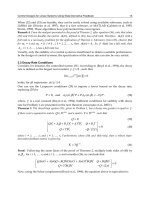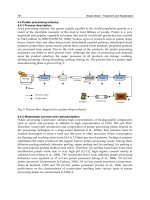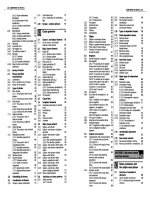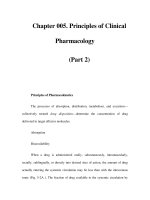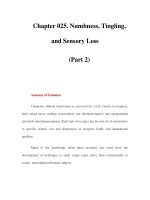Chapter 116. Immunization Principles and Vaccine Use (Part 2) ppt
Bạn đang xem bản rút gọn của tài liệu. Xem và tải ngay bản đầy đủ của tài liệu tại đây (16.73 KB, 6 trang )
Chapter 116. Immunization Principles
and Vaccine Use
(Part 2)
Approaches to Passive Immunization
Passive immunization is generally used to provide temporary immunity in a
person exposed to an infectious disease who has not been actively immunized; this
situation can arise when active immunization is unavailable (e.g., for respiratory
syncytial virus) or when active immunization simply has not been implemented
before exposure (e.g., for rabies). Passive immunization is used in the treatment of
certain illnesses associated with toxins (e.g., diphtheria) as well as for some snake
and spider bites and as a specific or nonspecific immunosuppressant [Rho(D)
immune globulin and antilymphocyte globulin, respectively]. Three types of
preparations can be used in passive immunization: (1) standard human immune
serum globulin for IM or IV administration; (2) special immune serum globulins
with a known content of antibody to specific agents (e.g., hepatitis B virus or
varicella-zoster immune globulin); and (3) specific animal antisera and antitoxins.
Postexposure Immunization
For certain infections, active or passive immunization soon after exposure
can prevent or attenuate disease expression. Recommended postexposure
immunization regimens are shown in Table 116-1. For example, giving either
measles immune globulin within 6 days of exposure or measles vaccine within the
first few days after exposure may prevent symptomatic infection. Nonimmune
pregnant women exposed to rubella can minimize clinical illness by postexposure
passive immunization; however, this measure may fail to prevent viremia and
infection of the fetus and thus may be followed by the congenital rubella
syndrome. Proper immunization for tetanus plays an important role in dirty-wound
management. The need for active immunization—with or without passive
immunization—depends on the wound's condition and the patient's immunization
history. Tetanus is rare among persons with documented receipt of a primary
series of tetanus toxoid doses. Tetanus immune globulin is helpful in patients with
clinical tetanus, but survivors must be actively immunized since the disease does
not stimulate protective levels of antitoxin antibody. Administration of rabies
immune globulin plus rabies vaccine in the immediate postexposure period is
highly effective in preventing disease. Similarly, for persons who have not been
actively immunized, administration of hepatitis A immune globulin within 2
weeks of exposure to hepatitis A virus is likely to prevent clinical illness.
Evidence also supports the efficacy of human hepatitis B immune globulin in
preventing disease after exposure. While no high-titer preparation is available for
postexposure protection against non-A, non-B hepatitis, standard human immune
serum globulin is efficacious. VariZIG, a highly purified preparation of human
antibody to varicella-zoster virus (VZV), is licensed in Canada for the prevention
of varicella in nonimmune pregnant women who are exposed to infected
individuals. At the time of this writing, this product is available in the United
States from the Centers for Disease Control and Prevention (CDC) under an
investigational new drug (IND) protocol or under an expanded-access program
through the U.S. Food and Drug Administration.
Table 116-1 Recommended Postexposu
re Immunization with
Immunoglobulin Preparations in the United States
Disease Indicated
Comments
Measles Yes
Standard human immune globulin is
recommended for exposed infants and adults
with normal immunocompetence (but with a
contraindication to measl
es vaccine) and for
immunocompromised patients exposed to
measles (regardless of immunization status).
Patients should be actively immunized 3–
6
months after immunoglobulin administration.
Recommended dose: 0.25–0.50 mL/kg (40–
80
mg of IgG/kg) IM; 80 mg of
IgG/kg for
immunocompromised contact; maximum, 15
mL.
Rubella No
Efficacy is unreliable; therefore, standard
human immune globulin is recommended for
administration only to antibody-
negative
pregnant women in the first trimester who have
a documented rub
ella exposure and will not
consider terminating the pregnancy.
Recommended dose is 0.55 mL/kg (90 mg of
IgG/kg) IM.
Tetanus Yes
Human tetanus immune globulin (TIG)
has replaced equine tetanus antitoxin because of
the risk of serum sickness with equine ser
um.
Recommended dose for postexposure
prophylaxis is 250–500 units of TIG (10–
20 mg
of IgG/kg) IM. Recommended dose for
treatment of tetanus is 3000–
6000 units of TIG
IM.
Rabies Yes
Human rabies immune globulin (RIG) is
preferred over equine rabies antise
rum because
of the risk of serum sickness with equine serum.
RIG or antiserum is recommended for
nonimmunized individuals with animal bites in
whom rabies cannot be ruled out and with other
exposures to known rabid animals.
Recommended dose of RIG is 20 IU
/kg (22 mg
of IgG/kg). Recommended dose of antiserum is
40 IU/kg. Rabies vaccine is given as well at 0,
3, 7, 14, and 28 days.
Hepatitis
A
Yes
Standard immune serum globulin is
given in a single dose of 0.02–
0.04 mL/kg or
(for continuous exposure) in a do
se up to 0.06
mL/kg every 5 months. Postexposure treatment
with hepatitis A immune globulin has not been
studied.
Varicella
Yes
VariZIG, a new Canadian purified
human immune globulin containing high-
titer
IgG antibody to varicella-
zoster virus, is
intende
d for patients without evidence of
immunity to varicella who are exposed to
infection and who are at high risk for severe
disease and complications. It is not currently
licensed in the United States but instead has
investigational new drug status. VariZIG
may
be obtained under expanded-
access provisions
for patients who meet the enrollment criteria
and choose to participate. Maximal benefit
requires administration within 96 h of exposure.
The recommended dose is 125 units/10 kg of
body weight, up to a maximum of 625 units.



